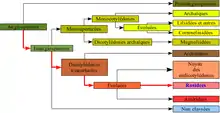Vivianiaceae
La famille des Vivianiaceae est une famille de plantes dicotylédones qui comprend une trentaine d'espèces en 2 à 3 genres.

Voir le texte pour plus d'information.

Ce sont des plantes herbacées ou des arbustes d'Amérique du Sud.
Étymologie
Le nom vient du genre type Viviania donné en hommage à Domenico Viviani (1772-1840), médecin et botaniste italien, professeur à Gênes et fondateur du jardin botanique, considéré comme le premier naturaliste ligure[1].
Classification
En classification classique de Cronquist (1981)[2] ce taxon est inexistant.
La classification phylogénétique APG III (2009)[3] inclut dans cette famille les genres précédemment placés dans la famille Ledocarpaceae à savoir les Balbisia (cs), Rhynchotheca (es), Wendtia.
En classification phylogénétique APG IV (2016)[4] les Vivianiaceae sont inclus dans les Francoaceae[5].
Liste des genres
Selon Angiosperm Phylogeny Website (31 mai 2010)[6] :
- genre Viviania
- genre Wendtia (attention Angiosperm Phylogeny Website place Wendtia aussi dans Ledocarpaceae)
(Balbisia, Rhynchotheca et Wendtia sont placés par Angiosperm Phylogeny Website dans Ledocarpaceae comme en APGII)
Selon NCBI (31 mai 2010)[7] (Plus conforme à APGIII puisqu'il incorpore les genres Balbisia et Wendtia anciennement dans Ledocarpaceae):
- genre Balbisia
- genre Viviania
- genre Wendtia
(NCBI (31 mai 2010)[7] ne reconnait pas Rhynchotheca)
Selon DELTA Angio (31 mai 2010)[8] :
- genre Rhynchotheca
- genre Viviania
Liste des espèces
- genre Balbisia
- Balbisia microphylla
- genre Viviania
- Viviania marifolia
- genre Wendtia
- Wendtia gracilis
Notes et références
-
- [PDF] (en) José A. Mari Mut, Plant genera named after people
- (en) Arthur Cronquist, An Integrated System of Classification of Flowering Plants, New York, Columbia University Press, (ISBN 0-231-03880-1, OCLC 1136076363, lire en ligne)
- (en) Angiosperm Phylogeny Group, « An update of the Angiosperm Phylogeny Group classification for the orders and families of flowering plants: APG III », Botanical Journal of the Linnean Society, Wiley-Blackwell, Linnean Society of London et OUP, vol. 161, no 2, , p. 105–121 (ISSN 0024-4074 et 1095-8339, DOI 10.1111/J.1095-8339.2009.00996.X)
- (en) Angiosperm Phylogeny Group, « An update of the Angiosperm Phylogeny Group classification for the orders and families of flowering plants: APG IV », Botanical Journal of the Linnean Society, Wiley-Blackwell, Linnean Society of London et OUP, vol. 181, no 1, , p. 1-20 (ISSN 0024-4074 et 1095-8339, DOI 10.1111/BOJ.12385)
- La classification phylogénétique APG IV sur Téla Botanica, mis en ligne jeudi 31 mars 2016 par Véronique Schafer. Consulté le 2 octobre 2016
- Stevens, P. F. (2001 onwards). Angiosperm Phylogeny Website. Version 14, July 2017 [and more or less continuously updated since]." will do. http://www.mobot.org/MOBOT/research/APweb/, consulté le 31 mai 2010
- NCBI, consulté le 31 mai 2010
- DELTA Angio, consulté le 31 mai 2010
Liens externes
- (en) Référence Angiosperm Phylogeny Website : Vivianiaceae ()
- (en) Référence DELTA Angio : Vivianiaceae Klotzsch.
- Voir aussi Geraniaceae, Ledocarpaceae
- (en) Référence Tree of Life Web Project : Vivianiaceae
- (en) Référence NCBI : Vivianiaceae (taxons inclus)
- (en) Référence GRIN : famille Vivianiaceae Klotzsch (+liste des genres contenant des synonymes)